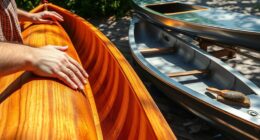To portage your canoe like a pro, start with lightweight materials such as Kevlar or fiberglass. Use a quality yoke for comfort and secure all gear to maintain balance. Plan your route to avoid obstacles, and be mindful of the terrain. When lifting, bend your knees and keep your back straight. Take smaller steps on uneven ground and find flat spots for breaks. Mastering these essentials will make your portaging experience smoother, so keep going for more tips!
Key Takeaways
- Choose lightweight canoes made from Kevlar or fiberglass for easier transport and reduced fatigue.
- Use a quality portage yoke for better weight distribution and enhanced comfort while carrying.
- Plan your portage route in advance to avoid obstacles and select suitable resting spots.
- Employ proper lifting techniques by bending knees and engaging core muscles to reduce strain.
- Stay aware of terrain changes and take breaks on flat ground to maintain balance and prevent fatigue.

Have you ever wondered what it takes to make portaging a breeze? If you’re planning a canoe trip, mastering the art of portaging is essential. It can mean the difference between a smooth, enjoyable experience and a grueling trek that leaves you exhausted. To carry your canoe like a pro, you’ll want to pay attention to both your canoe equipment and the portage techniques you use.
First off, let’s talk about the right canoe equipment. Choosing the right gear can considerably lighten your load and make your journey easier. Opt for a lightweight canoe that’s designed for ease of transport. Materials like Kevlar or fiberglass provide strength without the bulk. Additionally, consider investing in a good-quality portage yoke. This piece of equipment helps distribute the weight of the canoe evenly across your shoulders, making it much easier to carry. Don’t forget to secure all your gear properly; loose items can throw you off balance and make your trek more challenging. For added performance, consider incorporating suspension upgrades that can improve your overall carrying experience.
Choosing lightweight materials and using a quality portage yoke can significantly ease your canoeing experience.
Now, onto the portage techniques. When you approach a portage, take a moment to plan your route. Identify the best path and clear any obstacles in your way. Before lifting your canoe, bend your knees and engage your core to avoid straining your back. Position the yoke on your shoulders and ensure the canoe sits comfortably. As you lift, keep your elbows in and maintain a straight back. This technique minimizes fatigue and helps you maintain control.
While walking, stay aware of your surroundings. Look ahead to anticipate changes in terrain; this allows you to adjust your steps accordingly. If you encounter uneven ground or inclines, take smaller steps to maintain balance. If you need to take a break, find a flat spot to set down your canoe gently.
Frequently Asked Questions
What Should I Wear While Portaging My Canoe?
When you’re portaging your canoe, wear comfortable, moisture-wicking clothing that allows for easy movement. Proper footwear is vital; opt for sturdy, supportive shoes or boots that can handle uneven terrain. Don’t forget to take into account load distribution—balance your gear evenly to avoid strain. A hat and sunglasses can protect against the sun, while a lightweight rain jacket keeps you dry if the weather turns. Stay prepared and enjoy your adventure!
How Do I Prevent Back Pain During Portaging?
To keep your back from screaming like a banshee during portaging, focus on proper lifting techniques. Bend your knees, not your back, and keep the canoe close to your body as you rise. Invest in ergonomic gear, like a supportive padded yoke or back brace, to ease the load. Remember to take breaks, stretch, and adjust your grip; it’s all about moving gracefully, like a dancer gliding across the stage.
Can I Use a Trolley for Portaging?
Yes, you can use a trolley for portaging, and it offers several advantages. Trolleys make transporting heavy canoes easier, reducing strain on your back. They also allow you to navigate uneven terrain more smoothly. However, there are limitations; trolleys can be cumbersome in tight spaces and may not handle rough trails well. Consider your route and conditions to decide if a trolley suits your needs. It’s all about balancing convenience with practicality.
What Type of Canoe Is Best for Portaging?
For portaging, you’ll want a lightweight canoe, ideally under 60 pounds, to make carrying easier along portage routes. Look for designs that balance stability and maneuverability, like a solo canoe or a lightweight tandem. Materials like fiberglass or kevlar are great for weight reduction without sacrificing durability. Remember, the right choice depends on your comfort level and the length of your portage routes, so test a few models if you can.
How Long Does a Typical Portage Take?
A typical portage takes anywhere from 20 minutes to several hours, depending on your portage planning and gear selection. Imagine this: you’re sweating under the sun, lugging your canoe, when you spot a breathtaking view that makes every step worth it. To minimize time, choose lightweight gear and scout the route ahead. With a little preparation, you’ll breeze through the portage, leaving room for those unforgettable moments in nature.
Conclusion
Mastering the art of portaging can make your canoe adventures feel as effortless as gliding on a cloud. With the right techniques and gear, you’ll carry your canoe like a pro, transforming what once felt like a chore into an exhilarating part of your journey. Embrace the challenge, and don’t forget to enjoy the breathtaking views along the way. So grab your paddles, and let’s hit the water—your next adventure awaits!










